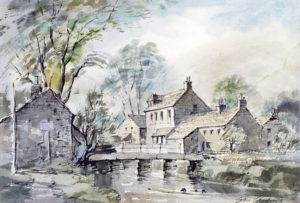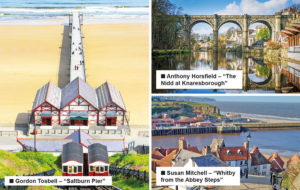The second in this series of three Yorkshire Dales walks is also in limestone country like last month’s walk around Ingleton and is a scenic circular walk visiting the four main attractions at Malham – Janet’s Foss, Goredale Scar, Malham Tarn and Malham Cove.
This walk visits four outstanding locations in the Malham area. These are in order of them being visited – Janet’s Foss, Goredale Scar, Malham Tarn and Malham Cove. There is a large car park in the centre of Malham where you will also find a very interesting information centre. It is a walk of contrasts with the walk starting through riverside pastures followed by limestone scrambles at Gordale Scar and then moorland over to Malham Tarn before returning back across the limestone clints above Malham Cove.
The walk starts from the Information Centre Car Park in Malham village (GR900627), which is very popular in summer and at weekends and therefore parking is at a premium at these times. Far better, if you can, visit either midweek or out of the main season and enjoy the peace and tranquillity that the area has to offer. The village of Malham is clustered around Malham Beck over which is a stone bridge in the centre of the village. Slightly south of the main bridge is a small footbridge, which should be used to cross the beck onto the eastern side. Follow the track across two fields until you reach a sign pointing to the left for Janet’s Foss. This is a good track that follows Gordale Beck across half a dozen fields to enter an ash wood and reach the fabulous Janet’s Foss waterfall. The wood is carpeted with wild garlic, which is very pungent in the spring.
The steep path to the left of the waterfall goes up to Gordale Bridge where you will see a sign on the left to Gordale Scar, approximately half a mile away at GR 915641. Gordale Scar cannot be seen until you round the corner at the end of the track and is a sight that takes the breath away even if you have visited this particular spectacle before. It contains two waterfalls and has overhanging limestone cliffs over 100 metres high. The gorge was formed by water from melting glaciers over eleven thousand years ago at the end of the ice age. A right of way leads up the gorge, but requires some mild scrambling over tufa (a variety of limestone, formed by the precipitation of carbonate minerals from ambient temperature water bodies) at the lower waterfall. By following the yellow spots on the rocks the route to the top of the Scar is achieved and at the top you need to turn left and head in a north-westerly direction.
However, for the faint hearted who feel that the scramble over these rocks is beyond their capabilities, they can return to Gordale Bridge and turn right into the field by the sign to Malham Tarn and once at the top of the field by the wall turn sharp right and follow across a grassed area to a small gate in the wall. The path then winds up the hillside (New Close Knotts) and as you ascend splendid views of Gordale Scar can be seen across to the right. The track now descends slightly and at a stile in the wall joins up with the track from Gordale scar.
This track continues in a north-westerly direction for a further mile until another stone stile is reached. At the stile turn right and follow it to Street Gate approximately 200 yards away. If you have time to spare it is worth passing through the gate to the green lane beyond – the start of Mastiles Lane leading to Kilnsey. Here you will find a monastic cross base on the left. Along the monastic roads, it was customary to place ‘crosses’ at prominent points, partly to stand as landmarks pointing the way and partly as a symbol of consecration or dedication to the service of the church. The crosses were often a rather plain stumpy shaft, either roughly squared or bevelled to a rough octagon, and set in a socket cut into a large base block. This base was sometimes only a rough boulder but in other cases it was squared-up and tooled. A total of five crosses are in the Malham Moor area with only the bases remaining in most cases.
At the signpost at Street Gate follow the sign for Arncliffe, drop down a dip in the landscape bearing slightly left by the wood of Great Close Plantation at which point the sight of Malham Tarn half a mile away appears. Head still along the track in a north-westerly direction to reach the tarn. One of the friends of Walter Morrison who built the Tarn was the author Charles Kingsley who used his stays here as an inspiration for his book “The Water Babies” published in 1863.
A natural upland lake brought to the surface by the north craven fault, Malham Tarn lies on a floor of older (400 million years old) impervious Silurian slate covered with thick glacial drift and marl deposits. It has a surface area of around 150 acres, average depth is approximately 2.4 metres and the maximum depth is around 4.4 metres. The tarn basis was dammed by a moraine from the retreat of the Devensian ice-sheet from the last ice age and prior to silting and mire development the tarn was originally twice its present size.
The inflow waters have passed through lime-rich soil, and the one outflow stream flows out for a short distance before sinking into the carboniferous limestone when it reaches the line of the north craven fault and re-emerges further down at Airehead springs. In 1791 the level of the tarn was raised by approximately four feet (1.2m) with the construction of the dam and weir at tarn foot by Lord Ribblesdale. Thus the previous shore-line and beach is now a drowned landscape and has also resulted in the erosion of tarn moss, a raised bog to the west of the tarn which has grown out at the mouth of the tributary streams coming off Fountains Fell. The tarn was granted to Fountains Abbey and its medieval monks by William de Percy in the 12th century, with all its fishing rights – the tarn has a reputation for its excellent trout. It also harbours a varied population of water birds – curlews, mallards, and greater crested grebe among them – protected in a sanctuary on the western shore.
Head south to the exit of the Tarn at Tarn Foot and turn right onto the road. Here, after about 100 yards there is a sign on the opposite side of the road marked “Pennine Way to Water Sinks”. Here, because of the change of the underground rocks from impervious slates to carboniferous limestone, the stream disappears and a Dry Valley is followed for a mile along the Pennine Way track to the grikes, clints and limestone pavements on the top of Malham Cove. Here, because of the absence of water, we encounter a “Dry Waterfall” and one can only imagine what this must have looked like when water was actually pouring over the edge of Malham Cove. It is 260 feet high, roughly the same as that at Niagara Falls. Describing the cove in 1779, Adam Walker said, “This beautiful rock is like the age-tinted wall of a prodigious castle; the stone is very white, and from the ledges hang various shrubs and vegetables, which with the tints given it by the bog water gives it a variety that I never before saw so pleasing in a plain rock.” The cove was featured in an episode of the BBC TV series Seven Natural Wonders as one of the natural wonders of Yorkshire and was also featured in the film Harry Potter and the Deathly Hallows (Part 1) as one of the places Harry and Hermione travel to. The scenes were filmed in November 2009.
Head to the right along the top of the limestone pavement to reach a set of constructed stone steps descending down to the bottom of the Cove. Here there is a good track crossing a clapper bridge of large stone slabs before a gentle rise to the Cove Road, which is then followed back down to Malham village where a good pint awaits you at the Buck Inn or Lister Arms. Opposite the Buck Inn are the premises of the female blacksmith Annabelle Bradley (www.annabellebradley.co.uk) who has provided the metal chandeliers in the Inn. The Malham Smithy was bequeathed to the Parish Church by Artist and Blacksmith Bill Wild, and has ever since been leased out by the Church as a traditional blacksmiths workshop. In February 2007, Annabelle Bradley was given the opportunity to work from the Malham Smithy and continues to this day keeping this beautiful Yorkshire Dales village heritage alive. The smithy was featured in 2011 in the ITV series The Dales. There are a couple of tea shops in the village serving food and drink. Meals are also available at the aforementioned Buck Inn and the Lister Arms.
Further details of this walk plus a further twenty nine walks can be found in my latest book Yorkshire Walks – 6 Dales – 30 Walks which is published by Sigma Publications. This is priced £9.99 and is available from most good bookshops or via the internet from Amazon or direct from Sigma Press at www.sigmapress.co.uk







